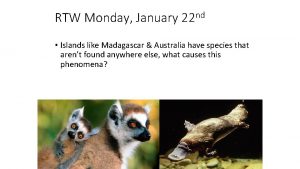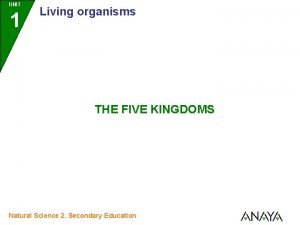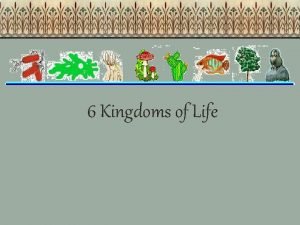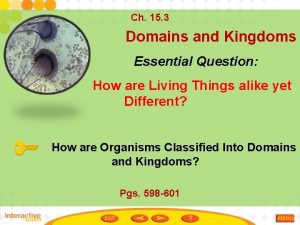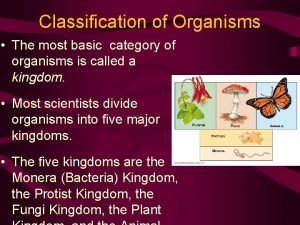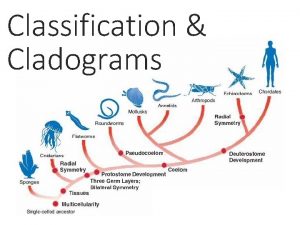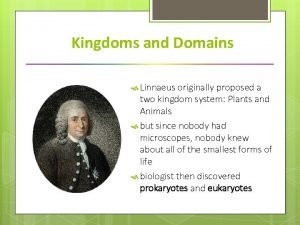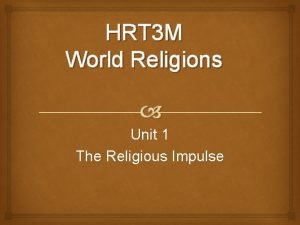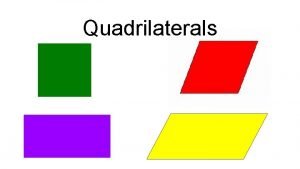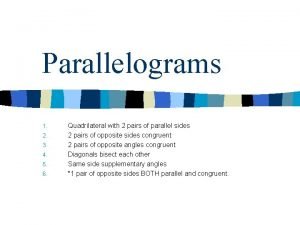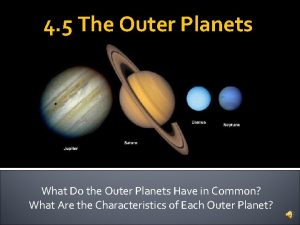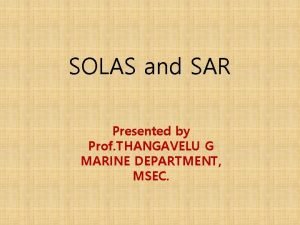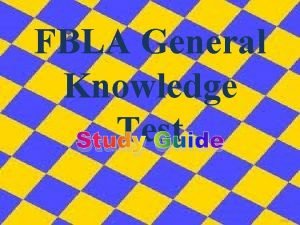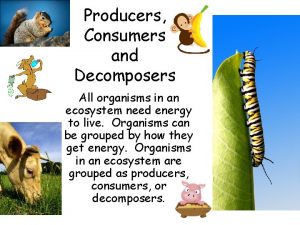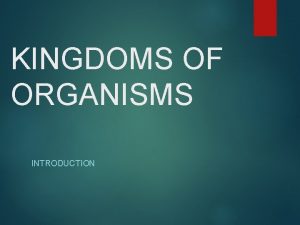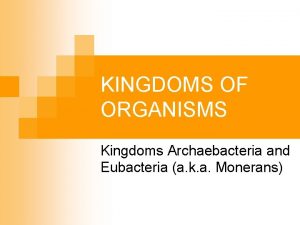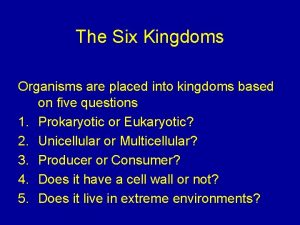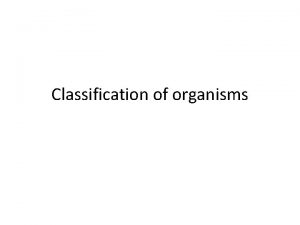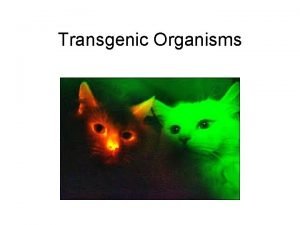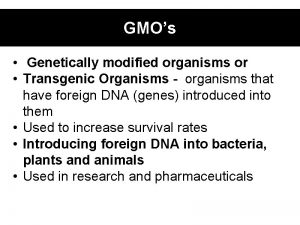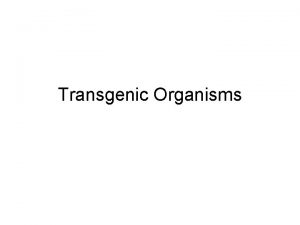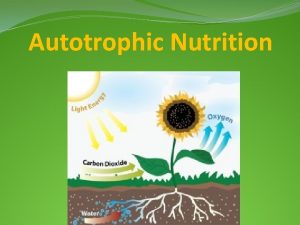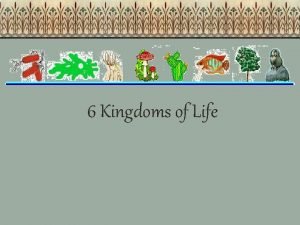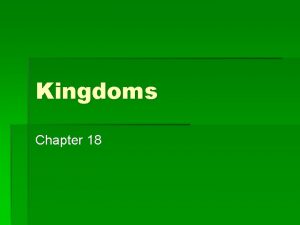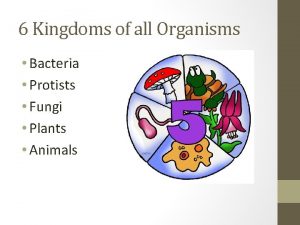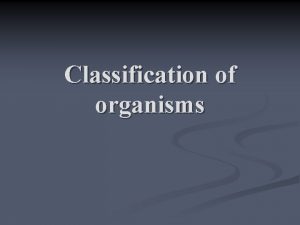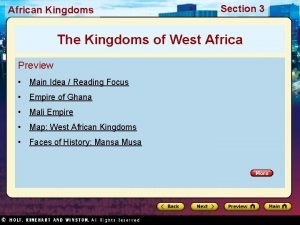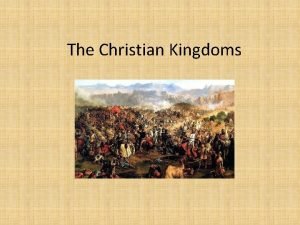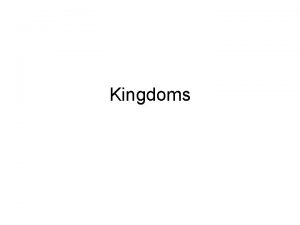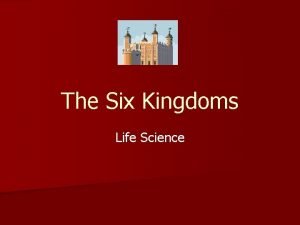KINGDOMS Chapters 18 21 All organisms have common

























- Slides: 25

KINGDOMS Chapters 18 -21

All organisms have common and scientific names v. While there may be many common names that vary from location to location, there is only ONE scientific name v. The scientific name is usually Latin or Greek v. This naming system is called Binomial Nomenclature

Binomial Nomenclature v. Entire word is italicized or underlined v 1 st word Genus (must be capitalized) v 2 nd word species (lowercase ) v. Examples v. Felis concolor Cougar v. Ursus arctos Bear v. Homo sapiens Humans v. Panthera leo Lion

Taxonomic Categories v. The Genus and species is part of a larger organization system, called Taxonomy. v. How are living things classified?

Domain: Highest level of classification v. Kingdom: General level of classification v. Phylum: A subdivision of a kingdom v. Class: Each phylum is divided into classes v. Order: Each class is divided into orders v. Family: Each order is divided into families v. Genus: Each family is divided into genera v. Species: Lowest level (represents a single type of organism)

Taxonomy includes 8 levels: Do Kings Play Checkers On Fat Green Stools? v. Domain v. Kingdom v. Phylum v. Class v. Order v. Family v. Genus v. Species

More alike Fewer numbers

Organizational System Human Lion Tiger Pintail Duck Animalia Phylum Chordata Class Mammalia Aves Kingdom Order Primate Carnivora Anseriformes Family Homindae Felidae Anatidae Genus Homo Panthera Anas Species sapiens leo tigris acuta



Domains v. Broadest category of classification v 3 Domains: v. Bacteria v. Archae v. Eukarya

Domain Bacteria v All are prokaryotes v Cell walls contain peptidoglycan v. Cellulose: plants like peptidoglycan: bacteria v Diverse group; can survive many different environments v Can be autotrophs or heterotrophs v Most abundant group

Domain Archaea v. Cell walls without peptidoglycan v. Diverse in shape v. Most are heterotrophs v. Can live in extreme environment

Domain Eukarya v. Kingdom Protista v. Do not have organs v 3 broad groups v. Plant like (algae) v. Animal like: protozoans (amoebas) v. Fungus like: slime molds and mildews

Domain Eukarya v. Kingdom Fungi v. Unicellular or multicellular v. Heterotrophs v. Lack mobility v. Have cell walls v. Thread like fliaments (hyphae): help with growth, feeding, reproduction

Domain Eukarya v. Kingdom Plantae v. Multicellular v. Have cell walls made of cellulose v. Most have chloroplasts (energy) v. Go through photosynthesis

Domain Eukarya v. Kingdom Animalia v. Heterotrophic, multicellular eukaryotes v. No cell walls v. Cells organized into tissues; tissues organized to organs v. Complex organ systems

Viruses v. They are the exception v. DO not belong to any domain v. Nucleic acid surrounded by a protein coat v. Do not have cells; they are not cells v. Not considered living

Number of Cells energy cell type examples Archaeunicellular bacteria some autotrophic, most prokaryote chemotrophic “extremophiles ” Euunicellular bacteria autotrophic prokaryote and heterotrophic bacteria, E. coli fungae most multicellular heterotrophic eukaryote mushrooms, yeast plantae multicellular autotrophic eukaryote trees, grass eukaryote humans, insects, worms eukaryote ameba, paramecium, algae animalia multicellular heterotrophic protista most unicellular heterotrophic or autotrophic

Dichotomous Key v. A dichotomous key is a reference tool used to determine the species of an unknown organism. v. The key has a series of choices that leads to the identification of the species

Example: Who can it be now?

Cladogram v. A cladogram is a way to organize things by what they have in common. v. They help understand how things are similar and different. v. It is a branching diagram that shows evolutionary relationships based on characteristics

Cladogram v. How to read a cladogram: v. The closer two organisms are grouped together on a cladogram, the more closely related they are v. An outgroup is the distantly related organism that starts a cladogram

CL D A M A R G O Notice that the cladogram has derived characters listed toward the bottom. What are some of the derived characteristics in this cladogram?

(1) (2) (3) (4) How are the perch and hagfish different? How are the lizard and pigeon the same? How is the chimp different from the pigeon? What characteristics do the chimp and mouse have in common?
 Which kingdoms have photosynthetic organisms? *
Which kingdoms have photosynthetic organisms? * Examples of animal organs
Examples of animal organs 3 domains and 6 kingdoms chart
3 domains and 6 kingdoms chart How are organisms classified into domains and kingdoms
How are organisms classified into domains and kingdoms Sixkingdoms
Sixkingdoms Which kingdoms contain organisms that are multicellular?
Which kingdoms contain organisms that are multicellular? Competitive interaction
Competitive interaction Unicellular/multicellular
Unicellular/multicellular The 6 kingdoms
The 6 kingdoms Common characteristics of the six kingdoms of life
Common characteristics of the six kingdoms of life What do these images have in common
What do these images have in common Wave 1
Wave 1 Symbol definition
Symbol definition What do all religions have in common
What do all religions have in common What do all shapes have in common
What do all shapes have in common What do all connective tissues have in common
What do all connective tissues have in common Every rhombus is a square
Every rhombus is a square What do all the outer planets have in common
What do all the outer planets have in common Name all rays
Name all rays The village by the sea summary chapter 1
The village by the sea summary chapter 1 Solas all chapters
Solas all chapters 6 faces 12 edges and 8 vertices
6 faces 12 edges and 8 vertices What was the first fbla state chapter
What was the first fbla state chapter How many states have tsa delegations (chapters)
How many states have tsa delegations (chapters) Producers decomposers
Producers decomposers Where do all organisms get their energy
Where do all organisms get their energy
